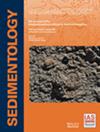Unidirectional and combined transitional flow bedforms: Controls on process and distribution in submarine slope settings
IF 2.8
2区 地球科学
Q1 GEOLOGY
引用次数: 0
Abstract
Mixed grain-size bedforms comprise alternating sand-rich and poorly sorted mud-rich laminae and bands. These bedforms have been identified in distal submarine settings formed underneath unidirectional flows. This study documents mixed grain-size bedforms in a proximal submarine slope setting formed beneath both unidirectional and combined flows. Core and outcrop data with well-constrained palaeogeographical context are used to describe two types of mixed grain-size bedform. Type A bedforms comprise mud-rich current ripples and low-amplitude bed-waves with alternating concave and planar sandstone–mudstone foresets that pass into mud-rich troughs, and aggradational sinusoidal laminasets. Type B bedforms consist of sandstone–mudstone laminasets that comprise rounded, biconvex ripples with sigmoidal-shaped foresets and swale and hummock-like laminasets and banded sets. These bedforms occur in channel-margin, internal-levée and external-levée, intraslope and disconnected lobe environments, and represent 27 to 63% by stratigraphic thickness of the studied successions. They are interpreted as deposits of clay-rich transitional flows, whose depositional style is governed by the balance of cohesive and turbulent forces, and the rate of flow deceleration. Type B bedforms are further interpreted as combined transitional flow deposits, resulting from flow deflection and ponding processes by seabed topography. Upward and lateral transitions between different bedforms create distinct bedform sequences, demonstrating progressive spatio-temporal transformations in flow properties and their topographic interactions. By using a well-constrained palaeogeographical setting, mixed grain-size bedforms are shown to be situated close to sites of erosion into muddy substrates, abrupt losses in confinement, and/or changes in slope gradient. These bedforms demonstrate that flow transformation and transitional flow behaviour are not restricted to distal submarine settings. Furthermore, mixed grain-size bedforms are not a diagnostic criterion for bottom currents, because such flows cannot account for the high mud content in laminasets, or the interlamination of sand and mud.单向和组合过渡流床形:海底斜坡环境中对过程和分布的控制
混合粒度床形由富含沙粒和分选较差的富含泥浆的层状和带状交替组成。在单向流下形成的远端海底环境中发现了这些床形。这项研究记录了在单向流和混合流下形成的近海底斜坡环境中的混合粒度床形。研究利用岩心和露头数据,结合严谨的古地理环境,描述了两种类型的混合粒度床形。A 型床形包括富含泥浆的水流涟漪和低振幅床波,砂岩-泥岩前缘交替呈凹形和平面状,进入富含泥浆的水槽,以及渐进的正弦波状层理。B 型床形由砂岩-泥岩层组组成,包括圆形、双凸波纹、乙字形前波、沼泽和驼峰状层组以及带状层组。这些层状出现在河道边缘、内坡和外坡、坡内和断裂裂片环境中,占所研究演替地层厚度的 27% 至 63%。它们被解释为富含粘土的过渡流的沉积物,其沉积方式受内聚力和湍流力的平衡以及水流减速率的影响。B 型床形则被进一步解释为过渡流的组合沉积,是海床地形造成的流动偏转和积水过程的结果。不同床形之间的向上和横向过渡形成了不同的床形序列,展示了流动特性及其地形相互作用的时空渐变。通过使用约束良好的古地理环境,混合粒度的床状地貌被证明位于被侵蚀成泥质基底、封闭性突然丧失和/或斜坡坡度变化的地点附近。这些床形表明,流动转变和过渡流动行为并不局限于远端海底环境。此外,混合粒径床形并不是底层流的诊断标准,因为这种流动无法解释层流中的高泥含量,也无法解释沙泥的交错。
本文章由计算机程序翻译,如有差异,请以英文原文为准。
求助全文
约1分钟内获得全文
求助全文
来源期刊

Sedimentology
地学-地质学
CiteScore
8.20
自引率
11.40%
发文量
94
审稿时长
6-12 weeks
期刊介绍:
The international leader in its field, Sedimentology publishes ground-breaking research from across the spectrum of sedimentology, sedimentary geology and sedimentary geochemistry.
Areas covered include: experimental and theoretical grain transport; sediment fluxes; modern and ancient sedimentary environments; sequence stratigraphy sediment-organism interaction; palaeosoils; diagenesis; stable isotope geochemistry; environmental sedimentology
 求助内容:
求助内容: 应助结果提醒方式:
应助结果提醒方式:


